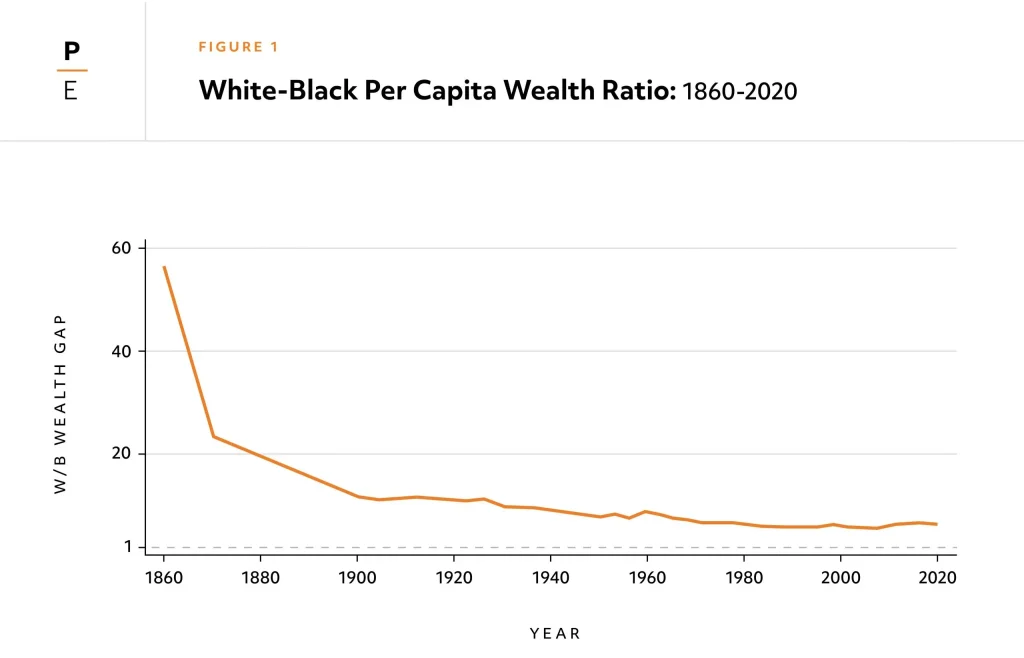The racial wealth gap is an enduring issue that underscores the persistent financial inequalities between different ethnic communities in the United States. Despite decades of efforts aimed at achieving racial economic parity, the reality remains stark: historical racism and systemic barriers contribute to what is often termed racial inequality. This wealth disparity is not merely a reflection of income differences but a complicated interplay of historical injustices and ongoing economic disenfranchisement faced by Black Americans and other marginalized groups. Wealth redistribution and economic justice initiatives have struggled to make a substantial impact, underlining the need for robust solutions to address these pervasive inequalities. As the nation grapples with these complex dynamics, understanding the roots and ramifications of the racial wealth gap becomes increasingly critical for crafting effective policies.
The term “racial economic divide” encapsulates the broader challenges of wealth disparity facing various racial groups in America today. This persistent divide is shaped by a legacy of systemic oppression and discriminatory policies that have historically impeded wealth accumulation for many communities of color. Solutions aimed at fostering economic justice can address the multi-faceted nature of this divide, which extends beyond mere financial statistics. By examining wealth concentration, historical injustices, and the need for equitable wealth redistribution, we can better understand the complex societal impacts. As discussions surrounding economic equality evolve, it is imperative to recognize that achieving true equity requires addressing both the historical context and contemporary manifestations of economic disparity.
Understanding the Racial Wealth Gap
The racial wealth gap is a longstanding economic issue that highlights the disparities in wealth accumulation between racial and ethnic groups, particularly between White and Black Americans. This gap is not merely a product of individual choices or differences in effort, but a systemic problem rooted in historical and structural inequalities. Factors such as discriminatory lending practices, housing policies, and unequal access to education have all contributed to the widening wealth gap, leaving Black Americans disproportionately disadvantaged compared to their white counterparts.
The origins of the racial wealth gap can be traced back to historical injustices such as slavery, segregation, and discriminatory policies that have systematically stripped wealth from Black communities. Even after the civil rights movement achieved legal equality, the gap persisted due to continued economic disparities and the legacy of systemic racism. Recent data suggests that despite various policies aimed at alleviating economic inequities, the wealth gap remains alarmingly stagnant, underscoring the complexity of achieving true economic justice.
Historical Context of Racial Economic Disparity
Understanding the historical context of racial economic disparity reveals the deep-seated roots of the issue in the United States. From the transatlantic slave trade to Jim Crow laws, systemic efforts were made to disenfranchise Black Americans and hinder their economic mobility. For instance, the practice of redlining in the mid-20th century explicitly denied Black communities access to mortgages and home ownership, critical pathways to building generational wealth. This segregationist agenda established patterns of poverty and disenfranchisement that have echoed through generations.
Historians argue that the economic structures created during and after slavery have shaped the current landscape of wealth distribution. The transformation of Black Americans into property, followed by their legal emancipation, left them without resources or capital needed to compete in a market economy. As structural inequalities continued to evolve, the policies meant to foster inclusion often fell short, as seen in the failure of the G.I. Bill to serve Black veterans equitably. This historical backdrop emphasizes that the racial wealth gap is not a new phenomenon but an enduring legacy of racial inequality that requires urgent attention.
The Role of Wealth Redistribution
Wealth redistribution has often been proposed as a solution to the racial wealth gap, aiming to address the disparities through targeted economic policies. This approach involves reallocating resources to create a more equitable playing field for marginalized communities. However, economic researchers have highlighted that simply redistributing wealth without addressing income disparities may not lead to long-term changes. The findings illustrate that even large cash transfers can have limited effects if the underlying income gap remains unresolved.
To effectively tackle the racial wealth gap through redistribution, policies must be designed to simultaneously boost income and wealth-building opportunities for underserved populations. Investing in education, providing job training and creating equitable access to financial resources are crucial steps that need to accompany redistribution efforts. Without addressing the root causes of income inequality, wealth redistribution alone might only serve as a temporary fix, rather than a sustainable solution for achieving economic justice.
Impact of Economic Justice Movements
Economic justice movements have played a pivotal role in raising awareness about the racial wealth gap and advocating for systemic change. Activists and scholars alike have emphasized the need for comprehensive policies that do not merely treat the symptoms of inequality but address its root causes. These movements focus on creating an equitable economy through initiatives like the Freedom Budget proposed by civil rights leaders, which argued for universal provisions to uplift all Americans, regardless of race.
These movements have shifted the narrative around wealth accumulation from individual merit to collective responsibility and systemic change. By advocating for policies that aim to dismantle institutional barriers, such as discriminatory lending and unequal education systems, economic justice movements highlight the interconnectedness of race and economic security. This expanded discourse offers hope for a future where the wealth gap can be narrowed through sustained advocacy and policy reforms.
The Complexity of Structural Racism
The complexity of structural racism in the context of the racial wealth gap underscores how deep-seated biases can manifest in ostensibly neutral policies. Discriminatory practices such as housing redlining, predatory lending, and unequal educational access have created barriers that are difficult for marginalized communities to overcome. These systems are perpetuated through policies that might not explicitly mention race, yet disproportionately affect racial minorities, allowing for the continuation of wealth disparities.
Moreover, structural racism also includes societal attitudes toward race and economic opportunity, which often hinder the progress of racial minorities. The persistence of stereotypes and prejudices can lead to discrimination in hiring practices, lending, and housing, compounding the disadvantages faced by Black Americans. Recognizing these complexities is essential for developing effective solutions that aim not just at economic equity, but also at changing the underlying societal attitudes that sustain structural racism.
Navigating the Challenges of Reparations
Reparations have emerged as a controversial yet essential topic in discussions surrounding the racial wealth gap. Advocates argue that reparations are critical to addressing the historical injustices inflicted on Black Americans, providing compensation for the generational harm caused by slavery, segregation, and systemic racism. Proposed measures for reparations include cash payments, land grants, and investments in Black communities, aimed at leveling the economic playing field.
However, the implementation of reparations faces numerous challenges, including political opposition and legal hurdles. Critics argue that the concept of reparations is unfeasible and could further divide the nation. Nonetheless, many advocates remain steadfast, asserting that reparations are not merely about compensation but about acknowledging history and rectifying the economic injustices that contribute to the ongoing racial wealth gap. The dialogue surrounding reparations continues to evolve, as more communities recognize the importance of reparative justice.
Evaluating Current Economic Policies
Current economic policies aimed at addressing wealth disparities must be critically evaluated for their effectiveness in bridging the racial wealth gap. Programs such as affirmative action and various welfare state initiatives have sought to provide support to marginalized groups. Yet, despite these efforts, significant disparities persist, suggesting that these measures alone are insufficient. Policymakers need to examine how these programs impact actual wealth accumulation and consider adjustments to enhance their effectiveness.
Beyond welfare support, policies should also focus on improving educational opportunities, increasing access to quality housing, and providing equitable employment practices. Enhancing these areas may restore some equity and offer a pathway for Black Americans to build sustainable wealth. Economic justice requires a multifaceted approach that acknowledges historical injustices while actively working to dismantle the current barriers that continue to perpetuate the racial wealth gap.
The Psychological Impacts of Income Inequality
The psychological impacts of income inequality, particularly among marginalized communities, can exacerbate the challenges associated with the racial wealth gap. Research shows that living in poverty can lead to stress, anxiety, and feelings of helplessness, which in turn can affect decision-making and family dynamics. These psychological burdens can hinder the pursuit of educational and economic opportunities, trapping individuals in cycles of poverty and limiting upward mobility.
Furthermore, the societal stigma associated with poverty can create barriers beyond financial constraints. Individuals facing racial and economic disparities may also deal with internalized racism and a lack of belief in their ability to succeed. Addressing these psychological factors is essential in any comprehensive strategy for closing the racial wealth gap, as improving mental well-being can empower individuals to take proactive steps towards economic advancement.
Future Directions for Economic Equity
The future directions for achieving economic equity require an integrated approach that combines education, political advocacy, and community-led initiatives. Policymakers and leaders must engage directly with affected communities to craft solutions that are not only effective but also equitable. This participatory approach can ensure that the voices of those most impacted by the racial wealth gap are heard and considered in crafting policies.
Additionally, leveraging technology and innovation to create opportunities for marginalized communities can facilitate economic growth. For instance, initiatives aimed at improving digital literacy and access can open doors for better job prospects, entrepreneurship, and wealth creation. By combining these strategies with a commitment to addressing historical injustices, there is potential to create a more equitable economic landscape for future generations.
Frequently Asked Questions
What is the racial wealth gap and how does it relate to racial inequality?
The racial wealth gap refers to the significant disparity in wealth accumulation between different racial groups, primarily between white Americans and Black Americans. This gap stems from historical factors, including systemic racism, discriminatory policies, and ongoing racial economic disparity, preventing equal access to opportunities and resources necessary for wealth building.
How do historical policies contribute to the racial wealth gap?
Historical policies, such as redlining and discriminatory lending practices, have reinforced the racial wealth gap by systematically excluding Black families from homeownership opportunities. These policies have resulted in long-lasting economic disadvantages, making wealth redistribution necessary for achieving economic justice and addressing the legacy of historical racism.
Why is addressing the racial wealth gap important for economic justice?
Addressing the racial wealth gap is crucial for achieving economic justice because it reflects broader societal inequities that persist due to historical oppression. Closing the gap can promote equal access to resources, better educational and employment opportunities, and ultimately foster a more equitable society where economic disparities are diminished.
What role does wealth redistribution play in reducing the racial wealth gap?
Wealth redistribution can help to reduce the racial wealth gap by providing resources to historically marginalized communities, allowing them to accumulate wealth and access services that promote economic mobility. However, studies suggest that without addressing the underlying income disparities and systemic issues, such efforts may only offer temporary relief.
How does the concept of economic justice relate to the racial wealth gap?
Economic justice relates to the racial wealth gap by advocating for fair distribution of resources and opportunities among all racial groups. It emphasizes dismantling structural barriers that perpetuate economic inequality and ensuring that policies favor equitable treatment, particularly for communities affected by historical racism and segregation.
Can reparations help to close the racial wealth gap?
Reparations are proposed as one strategy to help close the racial wealth gap by compensating communities adversely affected by historical injustices. However, discussions surrounding reparations often highlight the need for comprehensive solutions that also address persistent racial inequality and economic marginalization beyond financial compensation.
What are some current challenges in closing the racial wealth gap?
Current challenges in closing the racial wealth gap include ongoing discrimination, lack of access to quality education and employment opportunities, and socio-economic factors that contribute to wealth accumulation disparities. Additionally, policy shifts and the reduction of affirmative action and social support programs can exacerbate these challenges.
How does the intersection of race and class influence the racial wealth gap?
The intersection of race and class significantly influences the racial wealth gap, as class disparities often compound racial inequalities. Individuals from lower socio-economic backgrounds, regardless of race, face barriers to wealth accumulation, but systemic discrimination tends to disproportionately affect racial minorities, hindering their economic progress and amplifying wealth disparities.
What strategies can be implemented to address the racial wealth gap?
Effective strategies to address the racial wealth gap include promoting equitable access to education, implementing policies that support wealth-building initiatives, facilitating home ownership for marginalized communities, and advocating for systemic reforms that dismantle institutional racism. Comprehensive approaches must consider both income equality and wealth distribution to create lasting change.
How has the racial wealth gap evolved over time?
The racial wealth gap has evolved through various historical contexts, originally beginning with significant disparities post-Civil War and experiencing fluctuations through the Civil Rights era. However, today it continues to stagnate around a six to one ratio between white and Black households, indicating that while some progress has been made, deep-rooted issues persist that must be addressed.
| Key Points |
|---|
| Civil rights efforts for six decades have not significantly closed the racial wealth gap. |
| Economic research shows that simply redistributing wealth without addressing income disparities has little long-term impact. |
| Historical context reveals that African Americans arrived as property, complicating wealth calculations. |
| Black wealth has not substantially increased relative to white wealth since the mid-20th century. |
| Proposals like the Freedom Budget aimed for universal economic justice, but lacked political traction. |
| Recent analyses highlight that a focus on income inequality is crucial for addressing the wealth gap. |
| Persistent barriers such as systemic racism and economic policies continue to perpetuate the gap. |
Summary
The racial wealth gap remains one of the most pressing issues in American society, reflecting deep-seated inequalities rooted in history and policy. Despite decades of civil rights movements and some legislative progress, evidence shows that wealth disparities have stagnated, currently sitting at a ratio of approximately six to one between Black and white Americans. This persistence suggests that wealth inequality must be tackled through a multifaceted approach that not only addresses historical injustices but also seeks to enhance income opportunities and economic mobility for marginalized communities. Without targeted solutions, including comprehensive economic reforms and social investments, the racial wealth gap will likely continue to define the economic landscape of the United States.



